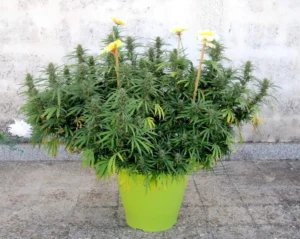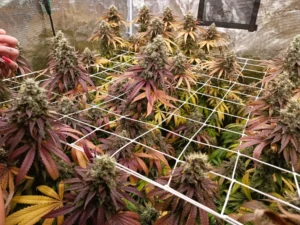All About Apical Pruning of Marijuana
Today, we’re diving into a very special technique in cannabis growing: an advanced pruning method designed to improve plant structure and boost yields. So, sit back, put on a song that makes you feel light, and enjoy the read, because today at Sweet Seeds®, we’re telling you everything you need to know about apical pruning of marijuana and how it works.
Are you ready?
What Does Apical Pruning Involve?
As the name suggests, apical pruning is related to the apex or tip of the plant. The method is quite simple: it consists of cutting off the top of the cannabis plant, specifically the main shoot. But hold on, young Padawan! There are still a few things you should know before you make the cut.
By applying this technique, you’ll see multiple benefits, such as increased development of lower and lateral branches. However, before proceeding, it is essential to understand how it will affect your plant to determine if this is the right approach for you. Keep reading to uncover all the secrets of apical pruning of marijuana, step by step.
Benefits of Apical Pruning
Apical pruning in the cannabis plant stimulates the development of two new main shoots that will grow in a Y shape, forming two new primary branches where there was previously only one. But this doesn’t just affect the top of the plant. In addition to halting vertical growth, the plant redirects its energy to secondary branches and the lower parts.
Over time, the plant’s original structure will change, becoming bushier, with growth spreading outward rather than upward. Additionally, the secondary branches will grow longer, sometimes reaching the same height as the primary ones.
This results in a cannabis plant that maximizes its available space and optimizes light distribution across all branches, leading to larger, high-quality buds throughout. It may take up less vertical space, but it will cover a larger surface area. Ultimately, this translates into a bigger yield, with denser, well-developed buds. Sounds good, right?
This technique is also highly useful for controlling the height of mother plants while promoting more branching for taking cuttings.
In summary, apical pruning is ideal for limiting plant height, improving light and space distribution, and achieving a higher total yield of premium-quality buds.
Techniques for Performing Apical Pruning
Now that you understand the goal of apical pruning, let’s go over the best way to carry it out.
As mentioned earlier, the method is simple: cut the main shoot, leaving the two lower shoots intact. However, keep in mind that this should not be done at just any time. Additionally, apical pruning does not affect all strains in the same way, so it’s essential to understand how different marijuana strains respond to this technique.
This method is not without its challenges, as it can be stressful for plants and leaves an open wound that makes them vulnerable to attacks. Use a healing paste or adhesive tape to seal the wound, helping the healing process and preventing the entry of pathogenic fungi in your beloved cannabis plants.
Apical pruning is a powerful tool in cannabis growing, so don’t be intimidated, and keep reading to uncover all its secrets.
Apical Pruning Indoors: Tips and Considerations
Applying apical pruning to indoor plants offers multiple benefits, as grow tents and grow rooms have height limitations.
As you know, maximizing the available space indoors is crucial, ensuring that every area exposed to light is utilized. Growing tall plants is not ideal because light only penetrates to a certain depth, often resulting in a single large central bud with multiple lower buds of lower density due to insufficient light intensity in that area.
Filling the grow space with plants typically requires a certain number of plants. However, with the use of the apical pruning technique indoors, the number of plants can be reduced since each one will cover a larger horizontal area. Additionally, the shorter height leaves more space between the tops and the light source.
As mentioned before, it’s important to understand how each strain responds, as not all react the same way to apical pruning. In strains with a more Indica tendency, this technique results in much shorter plants with a few lateral branches, balancing out the main shoots.
These strains tend to develop denser foliage, so light defoliation may be beneficial to allow better light penetration. The main bud will be slightly smaller, but this will be compensated by a greater number of medium-to-large-sized buds.
For Sativa-dominant strains, lateral and lower branch growth will be explosive, sometimes surpassing the main shoots. The plant structure will be sturdier, with stronger branches and stems. Overall, bud size will be significantly larger. In Sativa-dominant cannabis plants, combining this technique with LST is usually an excellent strategy to shape the plants and better control their growth.
Optimizing Apical Pruning in Outdoor Environments
Outdoor growing is primarily influenced by the solar cycle, as well as the location and climatic conditions where the grow operation takes place. Before performing apical pruning of marijuana outdoors, it’s worth considering a few important factors.
When pruning your marijuana plant outdoors, you’ll drastically alter its growth and structure. If you live in a very windy area, this pruning technique will help your plants withstand harsh weather conditions by developing a much stronger branch and stem structure—ideal for resisting strong winds.
With a bushier structure, the plant will be better protected from strong winds and prying eyes, whether from nosy neighbors or crop thieves. This technique is widely used on balconies and terraces for this very reason, as well as for making better use of the available space. Add a mesh, and you’ll have a recipe for success.
Apical pruning, combined with LST and trellising, is extremely useful in guerrilla grows or large-scale operations, such as those in countries where growing marijuana is legal. If you’ve ever seen giant plants several meters tall and wide, it’s almost certain that the grower used these techniques.
Outdoors, the response to pruning is less noticeable than indoors, as the sun shines on more parts of the plant than indoor overhead lighting. Nevertheless, as we’ve seen, it’s still a technique with significant benefits for the cannabis grower.
Keep reading to learn the ideal time to perform the apical pruning of marijuana plants.
The Most Effective Tools for a Successful Apical Pruning
Before discussing the ideal time to perform apical pruning of marijuana, let’s go over the necessary tools for this technique:
- Scissors or Blade: Ensure they are as sharp as possible to make a clean and precise cut. It’s advisable to sterilize them with alcohol before making the cut, which helps prevent the entry of diseases and fungi that could harm your cannabis plant if the tool is contaminated.
- Healing Paste: Applying healing pastes to wounds left after the cut helps reduce plant stress, speeds up wound healing, and prevents the entry of fungi and cryptogamic diseases. A simple homemade recipe involves mixing petroleum jelly or a vegetable oil, cinnamon, and modeling clay or candle wax, along with sulfur.
- Grafting Tape: If a large hole is left in the stem, it can be sealed with special grafting tape. It doesn’t offer the same benefits as the healing paste, but it aids in the healing process.
When Is the Right Time to Perform Apical Pruning of Marijuana Plants?
At this point, it is important to share information about the best time to perform apical pruning on marijuana plants. As you’ll see below, it’s quite simple: never do it once flowering has begun and always perform it from the 4th or 5th node onward.
Pruning during flowering would cause stress, which could lead to delayed flowering. Additionally, there wouldn’t be enough time for the plant to recover and grow the branches where future buds will form. This would likely result in disappointing flowering and reduced yields.
Performing apical pruning from a certain number of nodes is more related to the plant’s structure. It’s advisable to leave at least a minimum of 3 nodes below the cut, with 5 being ideal. This will maintain a good overall structure and balance between the branches, making the plant much more vigorous, with strong and flexible branches capable of withstanding buds with a good caliber.
Considerations About the Frequency of Apical Pruning
You’re probably wondering if you can perform multiple prunings in the same cannabis plant, and the answer is yes. But follow the same rule as in the previous section: don’t prune once flowering has begun, and respect the node rule.
In other words, the steps would be as follows: prune the cannabis plant and wait for the branches to grow until they have a minimum of 3 nodes (ideally 5) before performing the next pruning, which can be applied to all branches with the same number of nodes.
Indoors, this technique is commonly used on mother plants, where it’s ideal for maintaining good structure and controlled height. It’s very practical for obtaining numerous vigorous clones.
It also works well in outdoor grows, as the vegetative stage can last much longer, and logically, growth is more extensive.
An important point to consider is the fertilization rate for pruned plants. By performing apical pruning, you’re forcing the plant to develop more vegetative material, which means it will consume more nutrients.
Don’t skimp on feeding, as an apically pruned plant that doesn’t receive enough nutrients will suffer from stunted growth due to deficiencies and this may have a significantly negative impact in the final production of flowers.
How Does Apical Pruning Affect the Harvest of Buds?
Considering everything we’ve explained in this article, a well-executed apical pruning at the perfect time can result in an abundant harvest of high-quality buds. However, it’s essential to understand that performing apical pruning on every strain won’t always lead to a bigger harvest.
Some strains, such as our Gorilla Girl® (SWS74) or San Fernando Lemon Kush® (SWS62), respond very well to this type of pruning, as it helps manage their vigorous growth and efficiently distributes energy to the secondary branches of the plants.
On the other hand, in strains like Mohan Ram® (SWS09), apical pruning isn’t as practical. You might end up with plants that are overly bushy, with too many leaves and limited space for flower formation. In such cases, a well-executed SOG (Sea of Green) technique is a more suitable option.
Additionally, if your goal is to grow a large central bud, apical pruning would limit its growth. This is because the plant’s energy is distributed among the other branches, which end up “competing” with what would have been the main branch. Essentially, the plant balances its energy, spreading it out rather than concentrating it all in one central bud.
However, one thing is clear: a greater number of buds will reach a larger size, and the final harvest will be bigger, with higher-quality flowers overall.
Get the Best Seeds from Sweet Seeds®
Well, now that you have all the details about apical pruning of marijuana, it’s time to wield your lightsaber and ignite your next adventure: performing apical pruning like a true master of cannabis growing. But remember, make sure your strain selection includes the most vigorous and high-performing options: check out our catalog and find the cannabis strain that best suits your needs.
At Sweet Seeds®, we thank you for your trust and for choosing one of the leading seed banks to create your collection of top-quality cannabis seeds.
Thanks for reading, and see you in the next adventure!
Sweet Seeds S.L. is not responsible for any misuse of the information provided in this article. Growing Cannabis may constitute a criminal offense or administrative infraction; please check the Cannabis legislation applicable in your place of residence. Sweet Seeds S.L. does not, under any circumstances, intend to promote illegal practices.



